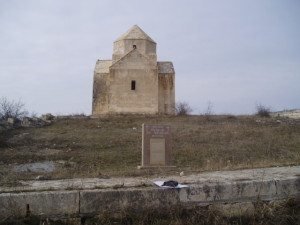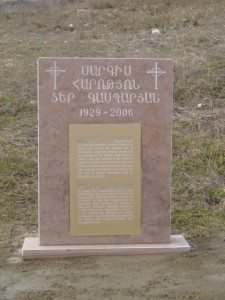“RADIOLUR,” the Public Radio of Armenia, carried an article on July 20 (reprinted below) which touched off a series of thoughts I desire to share with my fellow Armenians.
My family hails from Western Armenia—Dikranagerd, specifically. And, like many Armenians of that city, we were massacred and scattered to the four winds during the 1915 genocide. None of us have ever visited Dikranagerd since, but we still retain the deeds to property that was seized from us, and have never lost hope that one day justice will be served our people.
Given my background, one can imagine my delight upon learning that archaeologists had recently discovered another Dikranagerd—apparently one of several built by King Dikran the Great during his reign—this one being found in, of all places…Karabagh! One day, I hope to visit this “new” Dikranagerd, but in the meantime, when my brother Harry passed away three years ago, I consulted with his family and we agreed it would be appropriate and symbolic to bury his ashes there, on sovereign Armenian soil.
With the help of Karabagh Armenians, we were able to achieve our goal. My younger brother’s ashes are now buried in the garden before the restored church overlooking the city’s remains (see photographs). The epitaph on his gravestone is in Armenian, translated as follows:
“Sarkis Haroutiun Der Kasbarian was born in the United States of America in 1929 and died in 2006. He was the son of Hagop Der Kasbarian, a native of Alibunar, a village just outside the western wall of Dikranagerd, in Western Armenia. He was also the grandson of Der Kasbar, village priest of Alibunar, who was martyred in the Hamidian massacres of 1895. Sarkis Haroutiun is a son of Armenia, and his ashes rest here in Karabagh, near a historic site believed to be one of the four cities of ancient Dikranagerd (built by King Dikran the Great).”

And so, my brother’s spirit migrated from Dikranagerd to Dikranagerd.
If our family’s ancestral hearth cannot be reclaimed for now, then this tiny portion of liberated Karabagh will do just fine. Nevertheless, I worry. Given all the back-and-forth of recent negotiations, what will happen to this gravesite if the area is returned to Azerbaijan, especially given that country’s record of desecration of religious monuments? Will Karabagh go the way of Nakhichevan, which has been depopulated of Armenians, and yet retains its Armenian name?
Perhaps a proviso should be inserted in the agenda for any talks between the Armenians and Azerbaijanis. The proviso would require Azerbaijan to officially acknowledge such past desecrations (which have been documented by independent researchers) and make restitution, and include in any treaties assurances that such heinous crimes will no longer be tolerated.
***
Excavations to Prove Armenian Traces in Karabagh

By Lena Badeyan
While the world powers and politicians are trying to resolve the Karabagh issue, historians and archeologists are trying to prove that the territory has been originally Armenian. The Armenian specialists reached the greatest success in 2005, when they found one of the four Tigranakert cities founded by Armenian King Tigran the Great on the liberated land of Aghdam, to the southeast of Martakert region.
“For me this is Troy, this is how I would assess it. We continue finding different items here, but it’s not the most important. What’s important is that the city once existed here,” said Vardges Safaryan, member of the Tigranakert expedition, assessing the political and historical essence of the diggings.
“The two main walls and the towers of the Hellenic city have been discovered. The city was founded in the 80s B.C. and survived through the 15th century, about 1,500 years. That is why here we have not only Hellenic monuments, but also Christian ones. We have discovered an Armenian church built in 5th to 7th centuries, where we found one of the most interesting items last year—a clay, disk-like item with an engraving: ‘Me, Vache, the slave of God.’ This inscription dates back to the 6th to 7th centuries and it is the most ancient Armenian inscription found on the land of Karabagh up to now,” Vardges Safaryan said.
The authorities of Nagorno Karabagh also attach great importance to the excavations of Tigranakert and the government has been financing the works for about two years.


Great article
I was moved to the core
We will protect all current parts of Armenia including Artsakh province which includes Tikranakert from foreigners and those in Armenia bought out by foreigners. Shahumian, Martakert, Martuni and Naxijevan will be freed soon. No politician paid by US or Russia or anyone else owns Artsakh. It is first the people of Artsakh who own Artsakh. Then the rest of the Armenian people in other provinces and countries. No single person or organization can “sell” our province and our history.
Armenians should never ever surrender the lands surrounding Artsakh Proper. If the G8 or UN or any country calls these lands as occupied territories, then we should counter them by asking for the return of our territories that are currently occupied by Turkey (Western Armenia) and Azerbaijan (Nakhichevan).
Well said Leo.. I agree with you 100%..
I got chills when I read the article.. I hope to God that one day we will get what belongs to us and no government straight or faulty can take that away from us.
God Bless Armenia and its people..
G
My family also has many property deeds ( thousands and thousands of acres) from occupied Armenia: Hadjin and Adana. We should start documenting these or establishing a repository, as a definitive proof of our possessions. Then we can challenge Turkey in international courts to either restitute these properties or swap them with land adjacent to present Armenia. Unfortunately I have heard many people say that they had land deeds which they lost. Also there was a time ( in Lebanon in the 1960s) when some people sold their deeds to the Turkish government in the belief that we will never have another chance of reclaiming our homeland..
Don’t Give Back What Rightfully Belongs to Artsakh:
My understanding is that during the Soviet period Russia allowed Azerbaijan to take parts of what was then Artsakh/Karabagh and incorporate them into Azerbaijan itself. Thus, the Artsakh that Armenians have today, through their bravery, does not include all the territory that it should. I assume that at least some of those stolen lands are now part of the so-called “occupied territories” that are just outside Artsakh and which, in part or in whole, may be “returned” to Azerbaijan as part of a so-called “peace” agreement. (I think a better word for such a “peace” agreement might be “pees” agreement. “Pees” is the Turkish word for “dirty.”)
If this is the case, then Armenians are taking the wrong approach. At least some of the “occupied territories” are really part of Artsakh and should never be returned.
Have Artsakh and Armenia explained this to the OSCE and, publicly, to the world? I don’t think so. Armenians have many good arguments that could be used publicly but aren’t. Armenia seems stuck in the doldrums of the Soviet era when it comes to public relations.